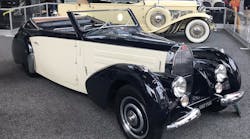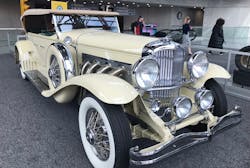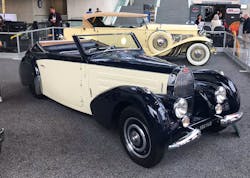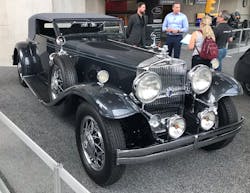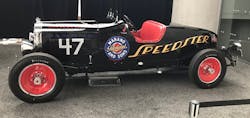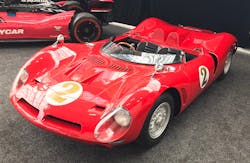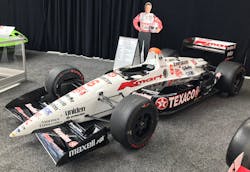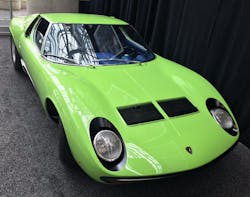Cars have been an American icon for independence, status, freedom, and more for many years. Many people think that cars are so American that Henry Ford invented the first one. He didn’t: Karl Benz invented the first internal combustion engine-driven car. The first name of Benz’s car company, Mercedes, comes from the 10-year-old daughter of Emil Jellinek, who set the specifications of the DMG model.
At this year’s New York City International Auto Show, the Saratoga Automobile Museum showed off some of the storied history of cars. The following was taken from the show, and information comes directly from the Saratoga Automobile Museum. If you’re ever in the area, check it out. (FYI: There’s a Cars & Coffee event sponsored by Dunkin Doughnuts on April 21st. )
1. Duesenberg Model J
The Duesenberg Model J’s debut at New York auto show in 1928 was front-page news. Even during the Great Depression, its power and luxury was a metaphor for prosperity and success. Known for their formal limousines, the Derham Custom Body Co. built relatively few open cars, and the Tourster design is considered to be the firm’s masterpiece. This Tourster J-448 is one of just eight built and one of the few to survive with its original body chassis and engine it is also the only Model J equipped with vertical Hood louvers.
Derham was located in Rosemont, Penn. on Philadelphia’s wealthy main line and crafted custom car bodies for the area's wealthiest families.
Production: 1928 to 1937
Assembly: Indianapolis, Ind.
Engine: 7L (420 cu in) DOHC Stright-8, optional supercharger
Transmission: 3-speed manual
2. 1938 Bugatti type 57C Stelvio Cabriolet by Gangloff
The type 57 Bugatti, introduced in 1934, marked Jean Bugatti’s emergence as the company’s leader and creative force. It was the first new model built under his direction and it incorporated many features that were new to Bugatti, including the first use of a transmission fixed the engine crankcase and a single patch plate clutch.
The C designation stands for the compresseur—meaning that this car’s twin cam 3.3 L straight-8 engine had the optional factory-installed supercharger. The best of France’s in Europe’s coachbuilders’ creations comprised the bulk of the Type 57 production. Bugatti’s clients could have the best. This Bugatti has beautifully proportioned coachwork by Gangloff, a Swiss/French coachbuilding company. The company was founded in 1903 by Georges Gangloff. Gangloff was one of the most important passenger vehicle coachbuilders after World War I. It produced bodies for Martini, Rolls Royce, Delage, Ansaldo, Hispano-Suiza, Isotta-Fraschini, Mercedes-Benz, Minerva, and of course Bugatti.
This is an extremely rare an authentic Type 57C Stelvio. It is an original a production chassis with desirable factory options, and the original engine and body. It was once owned by Prince Louis Napoleon Bonaparte.
Chassis no: 57677
Engine no: 31C
Engine: 3,257 Twin-choke Stromberg UUR2 Carb Roots type supercharger, 160 hp at 5,000 RPM
Transmission:4-speed Cotal Gearbox
3. 1931 Stutz DV-32
This 1931 Stutz is the only known LeBaron convertible Victoria on a DV-32 chassis. It is believed that this was a “catalog custom” intended to maintain LeBaron’s position as the dominant product for the Stutz chassis. In 1927 LeBaron developed a lightweight roadster body known as the Blackhawks Speedster. The success of the model led Stutz to arrange with LeBaron to be the consultants for the entire Stutz custom body program, and eventually all of the styling.
This car was imported as new to Argentina by South America’s Stutz distribution Luis Angel Firpo, a once-famous heavyweight boxer. The car return to the US in the mid-1970s and has been beautifully restored by its current owner.
Beneath the hood is the original 322 cubic inch straight-8 engine design by Charles Greuter, equipped with dual overhead camshaft and four valves per cylinder (hence the DV-32 designation, for dual camshaft 32-valves). Greuter’s design allowed for better breathing than the conventional two-valves-per-cylinder design, enabling the DV-32 engine to produce an impressive 156 horsepower nearly the same as the L-head V12s used by Lincoln and Packard. It also produced 43 horsepower more than the Stutz V16 engine which shared the 322 cubic inch displacement, but use a single overhead cam shaft and two valves per cylinder.
Exhibited at the 2016 Pebble Beach Concours d’Elegance, the Stutz earned first place in the American Classic Open category before being picked as one of the three finalists for best in show.
4. 1929 Packard Model 626 Racer
In the 1920s and 1930s, American automobile manufacturers seldom entered their own cars in race event, and Packard was no exception. “Gentleman Racers” would purchase their own cars and adapt them to race. That is what happened in the case of this 1929 Packard.
Packard was renowned as one of the finest-made American cars. The company’s advertising slogan was “Ask the man who owns one.” So a customer wanting to begin with the finest car available bought this car, removed its coupe body, fitted a much lighter boat tail racer body, modified the engine for more power, and started racing in oval track events and hill climbs in New York, New Jersey, and Pennsylvania. Ralph Marano restored the car to its current beautiful condition and has driven it in some vintage car races and hill climbs. He will be racing in the Hershey Hill-climb this June in Hershey, Penn.
5. 1967 Bizzarrini P538 Racer
The P538 was a multi-purpose race car. The name was deriven from the Chevrolet Corvette engine. The cylinder count and 5.3 L (5,358 actually) displacement lent their name with “P” for “posterior,” rear-engined.
This Bizzarrini P538 is a one-off creation built for competition such as CanAm and LeMans. It is powered by Lamborghini’s V12 engine, with six dual Weber carburetors, producing 420 horsepower. It has a 5-speed manual gearbox and a body constructed from fiberglass. Top speed achieved is 250 miles per hour, which was accomplished by the legendary Mark Donohue at Bridgehampton. This car is one of six, and Carries chassis number 002.
The P538 is the work of Giotto Bizzarrini, whose automotive pedigree includes developing the legendary 250 GTO Berlinetta for Ferrari. He engineered and created the V12 for Ferruccio Lamborghini, the radical A3C for iso-Grifo, and finally, his own marque, which includes the Bizzarrini 5300 Strada and the P-538.
6. 1994 Lola/Cosworth IndyCar Racer
This 1994 Lola/Cosworth T9400 IndyCar was piloted by American racing legend Mario Andretti in his final year of IndyCar competition, and it is from Mars Personal Collection. The car marks the culmination of Andretti’s 12 seasons with the Newman-Haas team, and was given to him by Paul Newman and Carl Haas as a retirement gift. During his tenure with one of the IndyCar Series’ premier teams, the Pennsylvanian named Driver of the Century both by the Associated Press and Racer magazine scored some 18 wins and 26 pole positions, and won the championship in 1984—his fourth IndyCar Championship. He remains the all-time record holder for Indy race starts with 407, and his 52 IndyCar wins rank second on the all-time list.
Often called the greatest race car driver of all time Andretti’s five-decade career is highlighted by 111 race wins including the Daytona 500 and Indianapolis 500, three wins at America's oldest sports car endurance race, the 12-hour Sebring, a Pikes Peak Hill Climb win, and winning the Formula One World Championship. No other race driver has accumulated as many wins over as long a period of time in as many different types of auto racing as Andretti.
7. 1972 Lamborghini Miura SV
Produced between 1966 and 1973, the Miura was the first super car from Lamborghini and quite possibly the first Supercar the world has ever seen. The Miura looked like no other car on the road, with its sensuous lines due to its transverse rear mid-engine two seat layout, now considered the standard for high-performance sports and supercars today. The Miura performance also matched its look and was often found in the garages of the most fashionable celebrities of the day. The design captured the useful spirit of the age. It was beautifully styled throughout and had intricate details such as the shape of the doors, which were supposedly modeled off of the horns of a raging bull.
The final iteration of the Miura, the SV, featured better handling thanks to revised suspension. But the most notable change was to the engine, which featured larger carburetors and different cam timing as they made the SV much more user-friendly at lower RPMs. With this engine producing 385 brake horsepower, the SV boasted incredible performance. A sprint to 60 mph from a standstill took just 5.8 sec., and its top speed was quoted at a 180 mph The SV can be distinguishable from its predecessor from its lack of “eyelashes” around the headlamps, wider rear fenders to accumulate accommodate the new 9-in.-wide rear wheels, and different taillights. 150 SVs were produced, and this is the last example of Lamborghini Miura SV imported into the U.S.
Production: 1966 to 1973
Engine: 3,929 cc V12
Transmission: 5-speed manual
8. 2017 Dallara IndyCar 2-Seat Racer
If all these fast cars give you the need for speed, get in and sit behind a professional race car driver as you experience the thrill of speeds allowed only on the race track. Okay, it’s not a classic, but I thought it was a little nuts/awesome that this car existed. The Indy Racing Experience has a fleet of two-seat ride-along IndyCars, with purpose-built chassis that allow you to sit behind the driver for an experience unlike any other. In fact, these cars are exclusive to IRE and will not be found anywhere else in the world.
The restrictions are, each person has to be over 18 and under 6-5 and 250 lb. If they just added a fake wheel with paddle shifters, it’d be the adult version of all those cars you find for kids at amusement parks. This experience will take you for two laps around the track at 180 mph while swaddled in carbon fiber.
